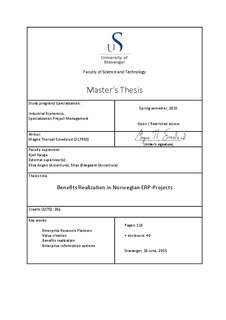| dc.description.abstract | Due to increasingly demanding business environments, many businesses choose to implement
Enterprise Resource Planners (ERPs) in order to obtain an integrated business structure to support
major business activities. These projects are costly, complex and very risky, though they have huge
potential for business benefits. Unfortunately, research points towards poor benefits realization in such
projects. Benefits realization management (BRM) is a project management methodology that aims
towards securing realization of such benefits through systematic work and management. However,
research also indicates modest focus on this methodology. This paper tries to identify as to what extent
Norwegian ERP-projects focus on BRM and measurement of achieved benefits.
Little research is found on this matter, apart from a few qualitative studies that point towards the same
results as mentioned above. Therefore, the author chose to use descriptive, quantitative surveys to
investigate this matter further. Through cooperation with relevant Special Interest Groups (SIGs), two
surveys were created and distributed to more than 2600 possible respondents, including both ERP
providers and clients. Even though every effort was made to secure enough feedback, the surveys only
received 42 responses in total. Due to this low response rate, the results are not generalizable, but they
do give some interesting indications that will have to be confirmed through further research.
Overall, the results show little focus on BRM in Norwegian ERP-projects. These surveys also show
that very few clients set specific requirements for BRM and measurements of benefits when
initializing such projects.
Specifically, more focus is devoted to the work with identifying benefits (the first stage of BRM) and
measurement of benefits post-implementation (as part of the fourth stage of BRM), compared to the
other activities. However, this was still focused on to between “lesser” and “some” extent, on average.
Few clients reported that they focus on measuring intangible benefits, and few projects set aside
dedicated resources for BRM and appointing benefits realization managers.
The results did also show a significant difference between responses from clients and vendors, of
which the latter undergo such projects more often. Overall, vendors report higher focus on BRM
compared to the clients, though there is still significant room for improvement.
Furthermore, the majority of the respondents (both vendors and clients) are not satisfied with their
own efforts with BRM, even though the majority clearly agrees that BRM is very important in such
projects.
Common barriers and reasons for excluding BRM in ERP-projects are too little focus, priority and
resources, in addition to reduced involvement from leadership. Few respondents reported difficulties
with the methodology itself as a barrier, aside from quantifying the benefits for measurements.
This thesis concludes that there is significant room for improvement with BRM in Norwegian ERPprojects.
The majority of the findings are aligned with previous research, where applicable. However,
the findings will have to be confirmed due to reduced generalizability of the results because of the low
response rates. | nb_NO |

